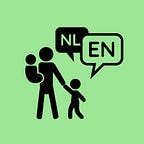Language development: stage of linguistic differentiation (2;6–5 years)
In this blogseries I will talk about the language development or acquisition of a child, both monolingual and bilingual (or multilingual). Be sure to read the previous blogposts about preverbal development, the one-word stage, the two-word stage and the introductory blogpost about the different stages I will mention and the most used defining terms. If at any moment you don’t understand the abbreviations used, go check them out here!
This post is divided into three sections, one for monolingual development (MFLA), one for simultaneous bilingual development (BFLA) and one for sequential bilingual development (SLA).
In this post I will talk about the stage of linguistic differentiation. This stage starts around the age of 2;6 years and lasts until the age of 5 years. In this stage the children’s social and cognitive skills improve massively, alongside the so called language explosion they seem to acquire. Everything goes fast and is learned fast, before you know it the child is 4 or 5 years old and no longer talking in that telegraphic style, but speaks in well versed sentences which are even fully intelligible! (Without too many mistakes in pronunciation)
Side note, as there is still a stage of language completion, not all aspects of language and communication are already finished at the end of this stage. However, to the layman’s ears it seems that way. Children this age may stammer and stutter, which is completely normal and in most cases goes away again as they develop further. As I’m not an expert on this matter, I will not discuss this further in here.
As written above, the language acquisition takes a fast track to completion in this stage. With monolingual children, this means that even though some articulation mistakes might be made the overal speech of children is fully understandable. Children understand the basics of grammar and can talk about this. Around the mark of 3 years, there is a big jump in active vocabulary and many children don’t seem to stop talking for a while and are actively searching for the meaning of words. In this, they can sometimes make mistakes such as saying the exact opposite of what they mean (“I’m last again!” when they are first). Also they are experimenting with the limits of the meaning of a word. For example, what is the difference between a nose and a trunk, and both attic and cellar are storage places vertically removed from the living areas, but which is which?
Many children will form new words (neologism) that might sound strange but are based on logical terms. Think of swimming bath (pool) and swallow out (spit out, opposite of swallow). This also happens a lot with adults (e.g. hangry), but children are masters in this. Also real questions are getting asked, where before they would have a different intonation in their sentence, or only asked basic questions like “what is that?”.
At last I will discuss overregulation. This is the extensive use of a rule that is just learned, but now used in almost all cases, even if those cases were previously correct. Children might conjugate irregular verbs regular again (I sleeped this night), or regular verbs suddenly irregular (just like I drink drank drunk, I pick pack puck). This happens not only with verbs but with any grammatical rules with exceptions and variations.
Just like the monolingual children, the children with BFLA see a big improvement in their language development. All the information I mentioned above are also relevant for the early bilinguals.
An added occurrence is the cross-linguistic influence. This influence is quite similar to the transfer I explained in the previous post. You can read about that here. With cross-linguistic influence, aspects of one language change (influence) aspects of the other language, and vice versa. This can be in all parts of language and speech, for example the accent, grammatical structures, word usage and pragmatics.
Depending on when SLA children started learning their languages, different characteristics of second language learning occur. The most common and noticeable is a silent period. A silent period is a span of time in which the child doesn’t speak in their new language, or not in any language. The last option is more often seen in younger of very self conscious children. This period is (subconsciously) used to absorb and learn as much of the new language as possible, without the need to focus on active use. Oftentimes the child will suddenly start talking (again) and then quickly improve and adapt to the new language situation. The younger children are when starting this silent period, the longer the period can last. This ranges from a few days to a few months and could even last up and until a full year. In the case of 6 months to a year though, the child should still converse in their mother tongue and follow a normal development. If this is not the case, or there are doubts and concerns about any other aspect of their development, it is wise to ask for an evaluation of a specialised professional.
Other characteristics of SLA can mainly be described as a prolonged period of the early linguistic stage and the use of telegraphic style sentences and grammar. You can read all about this here. One thing that is mentioned extra though, is the extra use of opposite word meanings, just as described in the MFLA part above. And just like with BFLA, cross-linguistic influence occurs with second language learners as well. It is most noticeable in language 2 (and 3 etc) however.
Originally published at https://intentionallybilingual.weebly.com.
